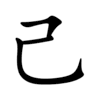己
| ||||||||
Translingual
| Stroke order | |||
|---|---|---|---|
| Stroke order | |||
|---|---|---|---|
 | |||
Han character
己 (radical 49, 己+0, 3 strokes, cangjie input 尸山 (SU), four-corner 17717, composition ⿱コ乚)
- Kangxi radical #49, ⼰.
Derived characters
- Index:Chinese radical/己
- 包 (Japanese form)
Descendants
- こ (Hiragana character derived from Man'yōgana)
- コ (Katakana character derived from Man'yōgana)
References
- KangXi: page 326, character 9
- Dai Kanwa Jiten: character 8742
- Dae Jaweon: page 630, character 10
- Hanyu Da Zidian: volume 2, page 983, character 5
- Unihan data for U+5DF1
Chinese
| simp. and trad. |
己 | |
|---|---|---|
Glyph origin
| Historical forms of the character 己 | ||||
|---|---|---|---|---|
| Shang | Western Zhou | Warring States | Shuowen Jiezi (compiled in Han) | Liushutong (compiled in Ming) |
| Oracle bone script | Bronze inscriptions | Chu Slip and silk script | Small seal script | Transcribed ancient scripts |
 |
 |
 |
 |
 |
| Characters in the same phonetic series (己) (Zhengzhang, 2003) | |
|---|---|
| Old Chinese | |
| 改 | *klɯːʔ |
| 跽 | *ɡrɯʔ |
| 己 | *kɯʔ |
| 紀 | *kɯʔ |
| 妀 | *kɯʔ |
| 記 | *kɯs |
| 杞 | *kʰɯʔ |
| 屺 | *kʰɯʔ |
| 芑 | *kʰɯʔ |
| 邔 | *kʰɯʔ, *ɡɯs |
| 玘 | *kʰɯʔ |
| 忌 | *ɡɯs |
| 鵋 | *ɡɯs |
| 誋 | *ɡɯs |
| 梞 | *ɡɯs |
Pictogram (象形) – silk rope for binding objects. Original form of 紀 (OC *kɯʔ).
Pronunciation
Compounds
Derived terms from 己
|
|
|
Japanese
Readings
Compounds
Derived terms
- 己巳 (Kishi)
Etymology 2
| Kanji in this term |
|---|
| 己 |
| つちのと Grade: 6 |
| kun’yomi |
Originally a compound of 土 (tsuchi, “earth”, one of the Chinese five elements) + の (no, possessive particle) + 弟 (oto, “younger brother”).
Proper noun
己 (hiragana つちのと, rōmaji Tsuchinoto)
- the sixth of the ten Heavenly Stems
- Hypernym: 十干 (Jikkan)
Etymology 3
| Kanji in this term |
|---|
| 己 |
| おのれ Grade: 6 |
| kun’yomi |
From 己 (ono, reflexive or first-person pronoun, see below) + れ (re, “thing”, demonstrative nominalizer ending).
Pronoun
己 (hiragana おのれ, rōmaji onore)
- reflexive pronoun: oneself
- first-person pronoun: I, me
- second-person pronoun: you (Can we verify(+) this sense?)
Derived terms
Derived terms
- 己と (onore to)
- 己やれ (onore yare)
- 己顔 (onoregao)
- 己奴 (onoreme)
- 己等 (onorera)
- 己を枉ぐ (onore o magu)
- 勝つは己に克つより大なるはなし (katsu wa onore ni katsu yori dai naru wa nashi)
Adverb
己 (hiragana おのれ, rōmaji onore)
- This term needs a translation to English. Please help out and add a translation, then remove the text
{{rfdef}}.- Synonyms: 自然に (shizen ni), 独りでに (hitori de ni)
Pronoun
己 (hiragana おのれ, rōmaji onore)
- This term needs a translation to English. Please help out and add a translation, then remove the text
{{rfdef}}.
Derived terms
Derived terms
- 己様 (oresama)
- 己共 (ondomo)
- 己奴 (oreme)
- 己等 (orera)
- 如己男 (mokoroo)
Alternative forms
Pronunciation
Pronoun
己 (hiragana うぬ, rōmaji unu)
- second-person pronoun: you
- reflexive pronoun: oneself
- Synonym: 自分自身 (jibun-jishin)
Derived terms
- 己等 (unura)
Interjection
己 (hiragana うぬ, rōmaji unu)
- This term needs a translation to English. Please help out and add a translation, then remove the text
{{rfdef}}.
Korean
Hanja
己 • (gi) (hangeul 기, revised gi, McCune–Reischauer ki)
- This term needs a translation to English. Please help out and add a translation, then remove the text
{{rfdef}}.
Vietnamese
Han character
己 (kỷ)
- This term needs a translation to English. Please help out and add a translation, then remove the text
{{rfdef}}.
This article is issued from
Wiktionary.
The text is licensed under Creative
Commons - Attribution - Sharealike.
Additional terms may apply for the media files.